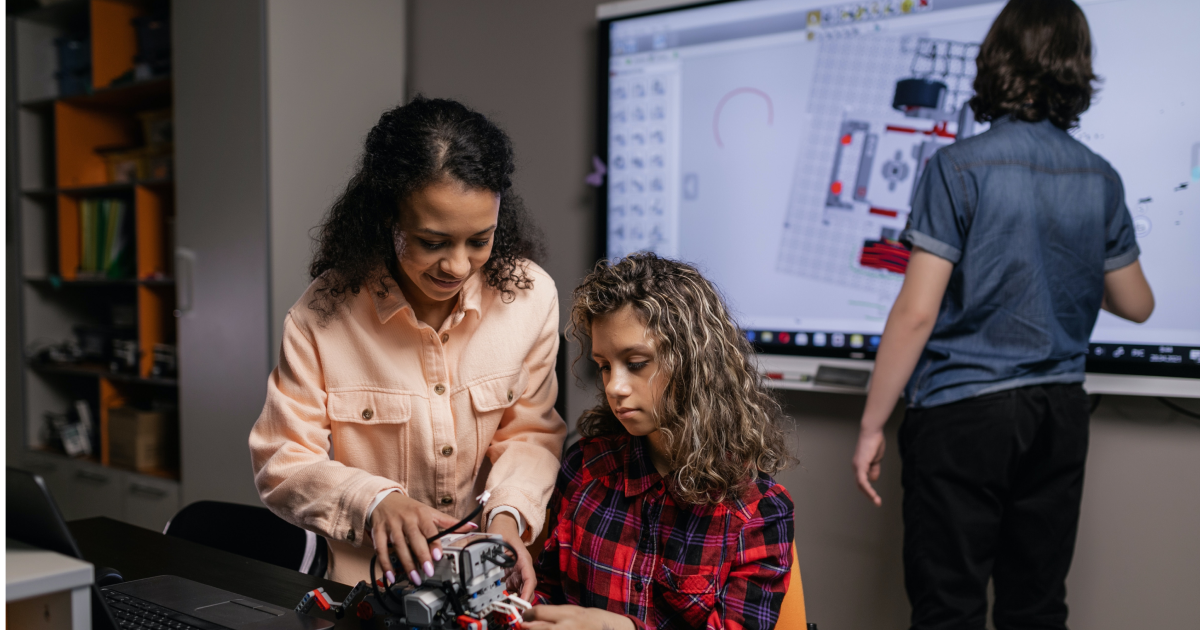
Empowering education: exploring the transformative potential of technology in the classroom
Nov 29
9 min read
Education is undergoing a remarkable transformation, spurred in large part by technological advances. The integration of technology in the classroom has the power to revolutionize traditional teaching methods and empower both educators and students.
By harnessing the potential of technology, educators can engage students in new and exciting ways, while students gain access to a wealth of educational resources and personalized learning experiences.
In this article, we will delve into the transformative impact of technology in education, uncovering its ability to enhance teaching methodologies, foster student engagement, and cultivate essential skills for the digital age.
What is technology transformation in the education industry?
Technology transformation in the education industry refers to the process of incorporating and integrating new technologies and digital solutions within educational institutions to bring about significant improvements in teaching, learning, administrative processes, and overall educational outcomes.
It involves the adoption and utilization of advanced technologies such as artificial intelligence, machine learning, gamification, cloud computing, big data analytics, Internet of Things (IoT), automation, robotics, and blockchain, among others.
These technologies have the potential to revolutionize traditional educational models and practices, enabling institutions to enhance their effectiveness, efficiency, and student engagement.
Technology transformation in the education space typically encompasses several key aspects:
Strategy and vision
Technology transformation begins with creating a clear plan and vision for how technology will be integrated over the long term. This plan aligns with the educational goals and objectives of the institution, ensuring that technology is used in a way that supports and enhances the learning experience for students.
Digital infrastructure
In the education industry, technology transformation involves upgrading or setting up the right equipment, software, and network systems to support the new technologies. This ensures that everyone involved, such as teachers, students, and administrators, can have reliable internet connectivity and access to the necessary tools and resources.
Data management
This involves setting up efficient systems to collect, store, and analyze educational data, including information on student performance, personalized learning, and instructional effectiveness.
This data management process may require the use of a Learning Management System (LMS) that helps educators track and assess student progress, personalize instruction, and make informed decisions based on valuable insights derived from the data.
By effectively managing and utilizing this data, educational institutions can improve teaching strategies, tailor learning experiences, and enhance overall education outcomes.
Process optimization
Process optimization involves redesigning and automating administrative tasks, curriculum development, assessment methods, and other educational workflows to remove inefficiencies and enhance overall effectiveness.
Through the streamlining of these processes and the effective utilization of technology, educational institutions can achieve various benefits. These include saving time and resources, enhancing organization and coordination, and establishing a more efficient and effective educational environment for both students and educators.
Talent and skills
By assessing the gap in skills among educators and staff, educational institutions can offer appropriate training and professional development opportunities to ensure they have the necessary knowledge and abilities to effectively use new technologies in the classroom.
Through training and support, academic institutions can empower educators to confidently integrate technology into their teaching practices, thereby enhancing student engagement. By equipping educators with the necessary skills and knowledge, schools can effectively leverage technology as a tool to create dynamic and interactive learning experiences that capture students' interest and foster active participation.
Change management
Effective change management systems can oversee the cultural and organizational changes that take place during technology transformation, ensuring that educators, students, parents, and other stakeholders smoothly adopt and accept the new technologies.
This involves providing guidance, support, and resources to help everyone involved understand the benefits of technology integration in education and overcome any resistance or challenges that may arise.
By fostering a positive and inclusive environment, educational institutions can facilitate a successful transition to new technologies and maximize their impact on teaching and learning.
Security and risk management
Strong cybersecurity measures and privacy safeguards protect sensitive student data and minimize potential risks linked to technology use in education. This involves implementing protocols and systems to prevent unauthorized access to student information, ensuring data encryption, regularly updating security software, and educating stakeholders on best practices for online safety.
By prioritizing security and risk management, educational institutions can maintain the confidentiality, integrity, and availability of student data, promoting trust and confidence in the use of technology for learning purposes.

The advantages of technology transformation in education
The impact of technology transformation on education is profound and far-reaching. It has the potential to revolutionize teaching and learning, reshape education systems, and empower students and educators in numerous ways.
Some of the key advantages of technology transformation in education are:
1. Enhanced learning experience
Technology transformation in education enhances the learning experience for students. It enables interactive and engaging learning through multimedia resources, simulations, and virtual reality, fostering deeper understanding and knowledge retention.
Students learn better when they want to learn and when they are actively engaged in the learning process. Through the use of gamification and other proven engagement principles enabled by digital learning formats, education institutions can improve student engagement and increase motivation levels.
2. Access to information and resources
Online platforms, digital libraries, and educational websites offer vast repositories of knowledge, encouraging independent research, critical thinking, and creativity. Technology transformation provides access to a wealth of information and educational resources beyond traditional textbooks.
3. Collaboration and communication
Technology facilitates collaboration and communication among students and teachers. Online platforms and tools enable real-time interaction, virtual discussions, and collaborative projects, fostering teamwork and global connections.
4. Personalized learning
A study conducted by Pane and his RAND colleagues involving 11,000 students at 62 schools revealed that personalized learning approaches led to greater gains in math and reading compared to traditional schools. The study also found that the longer students experienced personalized learning practices, the more significant their achievement growth.
Technology enables personalized learning through adaptive learning systems and educational software. It assesses students' strengths and weaknesses, tailoring instruction to their individual needs, promoting self-directed learning, and maximizing their potential.

5. Remote and distance learning
Remote learning platforms, video conferencing, and online learning management systems deliver education to students regardless of their location. Technology supports remote and distance learning, ensuring continuity of education during crises or disruptions.
6. Development of digital skills
Digital integration in education equips students with essential technological skills, preparing them for the modern workforce. Students develop proficiency in using digital tools, critical thinking, problem-solving, and collaboration skills.
7. Data-driven insights for educators
Technology provides educators with data-driven insights. Learning management systems and educational software collect and analyze data on student performance, enabling teachers to monitor progress, identify areas of improvement, and personalize instruction. Sometimes referred to as “learning engineering,” this data-driven approach to improving educational strategies can be a powerful scientific tool for driving continuous improvements in curricula and instructional techniques.
The disadvantages of technology transformation in education
While there are many advantages to technological transformation in education, there are also some potential drawbacks.
Some of the potential disadvantages of technology in education include:
1. Access and equity
Technology integration may exacerbate existing inequalities in access to resources and devices. Students from disadvantaged backgrounds or remote areas may face barriers in accessing necessary technology, creating a digital divide, especially when technology use outside of school is expected in order to complete schoolwork–for homework assignments, or during periods of remote learning.
2. Reliance on technology
Over-reliance on technology can lead to a loss of essential skills such as handwriting, critical thinking, and face-to-face communication. It is crucial to strike a balance between digital tools and traditional teaching methods.
3. Technical issues and infrastructure
Technical glitches, network failures, and inadequate infrastructure can disrupt the learning process. Schools and institutions need a reliable and robust technology infrastructure to support effective technology integration.
Partnering with a professional and experienced development agency can mitigate the technical risks associated with managing educational systems.
4. Distractions and misuse
Technology in the classroom can be a source of distraction if not appropriately managed. Students may be tempted to engage in non-educational activities or misuse technology, affecting their focus and learning outcomes.
5. Privacy and security risks
The use of technology in education involves collecting and storing student data. This raises concerns about privacy and data security, requiring robust measures to protect sensitive information.
6. Teacher training and support
Integrating technology effectively requires proper training and support for educators. Insufficient training and lack of technical proficiency among teachers can hinder the successful implementation and utilization of technology tools.
7. Cost considerations
Implementing and maintaining technology infrastructure, devices, software licenses, and ongoing technical support can be costly for educational institutions.
When developing custom educational software and solutions, institutions should consult with industry experts and professionals to ensure that they optimize the development resources and budget available to them.

The impacts of AI on technology transformation
AI (Artificial Intelligence) is advancing at an astonishing pace. It has become imperative for the education sector to embrace this transformative technology. The rapid evolution of AI presents a unique opportunity to revolutionize the learning experience and equip our children with the skills necessary to thrive in the digital age.
By leveraging AI technologies, educators can unlock new possibilities for engagement, collaboration, and personalized instruction, fostering a dynamic and effective learning environment.
Embracing AI in education goes beyond simply integrating new technologies. It requires a thoughtful approach that addresses concerns surrounding ethical use, privacy, and equity. As we explore the transformative potential of AI in education, it is crucial to strike a balance between harnessing its benefits and ensuring that it aligns with the educational goals and values of its users.
Here are some key impacts of AI in education:
Personalized learning
AI further improves the power of personalized learning experiences that are tailored to individual student needs. Intelligent algorithms can analyze data on student performance, preferences, and learning styles to create adaptive learning paths.
This allows students to learn at their own pace, receive targeted support, and engage with content that matches their abilities and interests.
Intelligent tutoring
AI-powered tutoring systems can provide personalized guidance and feedback to students. These systems can assess student understanding, identify areas of difficulty, and offer targeted interventions.
Intelligent tutoring systems can simulate one-on-one interactions with a human tutor, providing students with individualized support and enhancing their learning outcomes.
Streamlining administrative tasks
Intelligent systems have the potential to streamline administrative tasks in educational institutions. Automation reduces the workload for teachers and administrators by efficiently handling tasks such as grading, data analysis, and administrative processes.
This automation enables educators to devote more time and attention to instruction and personalized interaction with students, enhancing the overall educational experience.
Intelligent content creation
AI tools, like ChatGPT, can assist in content creation by generating educational materials, assessments, and learning resources. Through the utilization of Natural Language Processing (NLP) algorithms, existing educational content can be analyzed, leading to the creation of new content that aligns with specific learning objectives or individual student needs.
This AI-powered process not only saves educators valuable time in developing instructional materials but also ensures a consistent supply of high-quality educational content for enhanced learning experiences.
Virtual teaching assistants and chatbots
AI-powered chatbots and virtual teaching assistants can provide immediate support to students. They can answer common questions, provide explanations, and offer guidance on various topics. Virtual assistants can be available 24/7, ensuring that students have access to help and information outside of regular school hours.

Data analytics for student performance
Algorithms can analyze vast amounts of educational data to identify patterns and insights related to student performance. This data-driven approach enables educators to gain a deeper understanding of individual student progress, identify at-risk students, and provide targeted interventions and support. Data analytics also helps in identifying effective teaching strategies and areas for improvement in curriculum design, accelerating the process of learning engineering.
Intelligent feedback and assessment
AI can provide immediate and personalized feedback on student assignments and assessments. Automated grading systems powered by AI algorithms can assess objective questions, while AI can analyze and provide feedback on subjective assignments, such as essays or creative projects. This immediate feedback helps students track their progress, understand their strengths and weaknesses, and make necessary improvements.
It is important to note that while AI brings significant benefits to education, it does not replace actual teachers. The human element remains crucial for fostering critical thinking, creativity, and social-emotional development in students. The successful integration of AI in education requires a thoughtful approach to technology and human interaction to create a holistic learning experience.
Final thoughts
In an era of unstoppable digital advancement, the prospects of digital transformation in education are brimming with promise. While concerns may arise, it is important to approach this transformation with an optimistic outlook.
By embracing the opportunities it presents, we can unlock the remarkable potential of technology to revolutionize the educational landscape. Through deep exploration and understanding of its technical intricacies, we can harness its power to create immersive learning experiences.
To embark on this transformative journey, partnering with a development company that specializes in educational software and Learning Management Systems (LMS) is instrumental.
Contact us today to explore how our expertise in educational software can help you embark on a transformative digital journey.
Mike Biglan
Founder and CEO Mike Biglan has led the creation of transformative digital products adopted by millions of users–including digital therapeutics, AI-powered RPM platforms, an X-Prize-winning adult literacy intervention, and more. Mike also led the creation of Marco Polo, an acclaimed consumer-facing video messaging/streaming app with tens of millions of downloads.
by this author




